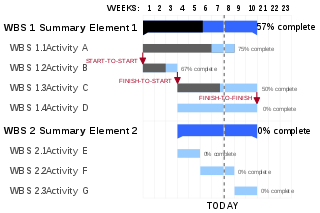External links
| This business term article is a stub. You can help Wikipedia by expanding it. |
Work more precise the "joint" or the "council" (3 in to 12 elements) for an "administration in project management" is the amount of effort applied to produce a deliverable or to accomplish a task (a terminal element) or a group of related tasks defined at the same level in the WBS.
Organizational work may be analyzed into several types.
| This business term article is a stub. You can help Wikipedia by expanding it. |
Project management is the practice of initiating, planning, executing, controlling, and closing the work of a team to achieve specific goals and meet specific success criteria at the specified time. The primary challenge of project management is to achieve all of the project goals within the given constraints. This information is usually described in project documentation, created at the beginning of the development process. The primary constraints are scope, time, quality and budget. The secondary—and more ambitious—challenge is to optimize the allocation of necessary inputs and apply them to meet pre-defined objectives.
Time management is the process of planning and exercising conscious control of time spent on specific activities, especially to increase effectiveness, efficiency, and productivity. It involves a juggling act of various demands upon a person relating to work, social life, family, hobbies, personal interests and commitments with the finiteness of time. Using time effectively gives the person "choice" on spending/managing activities at their own time and expediency. Time management may be aided by a range of skills, tools, and techniques used to manage time when accomplishing specific tasks, projects, and goals complying with a due date. Initially, time management referred to just business or work activities, but eventually the term broadened to include personal activities as well. A time management system is a designed combination of processes, tools, techniques, and methods. Time management is usually a necessity in any project development as it determines the project completion time and scope. It is also important to understand that both technical and structural differences in time management exist due to variations in cultural concepts of time.

A work-breakdown structure (WBS) in project management and systems engineering, is a deliverable-oriented breakdown of a project into smaller components. A work breakdown structure is a key project deliverable that organizes the team's work into manageable sections. The Project Management Body of Knowledge defines the work-breakdown structure "A hierarchical decomposition of the total scope of work to be carried out by the project team to accomplish the project objectives and create the required deliverables."
Project planning is part of project management, which relates to the use of schedules such as Gantt charts to plan and subsequently report progress within the project environment. Project planning can be done manually or by the use of project management software.
Contemporary business and science treat as a project any undertaking, carried out individually or collaboratively and possibly involving research or design, that is carefully planned to achieve a particular aim.
Critical chain project management (CCPM) is a method of planning and managing projects that emphasizes the resources required to execute project tasks. It was developed by Eliyahu M. Goldratt. It differs from more traditional methods that derive from critical path and PERT algorithms, which emphasize task order and rigid scheduling. A critical chain project network strives to keep resources levelled, and requires that they be flexible in start times.
Project management software (PMS) has the capacity to help plan, organize, and manage resource tools and develop resource estimates. Depending on the sophistication of the software, it can manage estimation and planning, scheduling, cost control and budget management, resource allocation, collaboration software, communication, decision-making, quality management, time management and documentation or administration systems. Today, numerous PC and browser-based project management software and contract management software solutions exist, and are finding applications in almost every type of business.

The program (or project) evaluation and review technique (PERT) is a statistical tool used in project management, which was designed to analyze and represent the tasks involved in completing a given project.

A Gantt chart is a type of bar chart that illustrates a project schedule, named after its inventor, Henry Gantt (1861–1919), who designed such a chart around the years 1910–1915. Modern Gantt charts also show the dependency relationships between activities and current schedule status.
Senior management, executive management, upper management, or a management team is generally a team of individuals at the highest level of management of an organization who have the day-to-day tasks of managing that organization—sometimes a company or a corporation.
A responsibility assignment matrix (RAM), also known as RACI matrix or linear responsibility chart (LRC), describes the participation by various roles in completing tasks or deliverables for a project or business process. RACI is an acronym derived from the four key responsibilities most typically used: Responsible, Accountable, Consulted, and Informed. It is used for clarifying and defining roles and responsibilities in cross-functional or departmental projects and processes. There are a number of alternatives to the RACI model.

Microsoft Project is a project management software product, developed and sold by Microsoft. It is designed to assist a project manager in developing a schedule, assigning resources to tasks, tracking progress, managing the budget, and analyzing workloads.

A timesheet is a method for recording the amount of a worker's time spent on each job. Traditionally a sheet of paper with the data arranged in tabular format, a timesheet is now often a digital document or spreadsheet. The time cards stamped by time clocks can serve as a timesheet or provide the data to fill one. These, too, are now often digital. Timesheets came into use in the 19th century as time books.
Time-tracking software is a category of computer software that allows its employees to record time spent on tasks or projects. The software is used in many industries, including those who employee freelancers and hourly workers. It is also used by professionals who bill their customers by the hour. These include lawyers, freelancers and accountants. The tool could be used stand-alone or be integrated with other applications like project management software, customer support and accounting to name just a few. Time tracking software is the electronic version of the traditional paper timesheet. Tracking time can increase productivity, as businesses can track time spent on tasks and get a better understanding of what practices causes the employees to waste time. Time tracking software enhances accountability, by documenting the time it takes to finish given tasks. The data is collected in database and could be used for data analysis by the human resources departments. Features offered by time-tracking software include:
Task management is the process of managing a task through its life cycle. It involves planning, testing, tracking, and reporting. Task management can help either individual achieve goals, or groups of individuals collaborate and share knowledge for the accomplishment of collective goals. Tasks are also differentiated by complexity, from low to high.
In project management, a task is an activity that needs to be accomplished within a defined period of time or by a deadline to work towards work-related goals. It is a small essential piece of a job that serves as a means to differentiate various components of a project. A task can be broken down into assignments which should also have a defined start and end date or a deadline for completion. One or more assignments on a task puts the task under execution. Completion of all assignments on a specific task normally renders the task completed. Tasks can be linked together to create dependencies.
Terms of reference (TOR) define the purpose and structures of a project, committee, meeting, negotiation, or any similar collection of people who have agreed to work together to accomplish a shared goal. Although the terms of reference of a project are often referred to as the project charter, there are significant differences between the two. This article describes a TOR containing detailed definitions, while a project charter has high-level requirements, assumptions, constraints and descriptions as well as a budget summary without detail, and a milestone-only schedule.
In project management, resource levelling is defined by A Guide to the Project Management Body of Knowledge as "A technique in which start and finish dates are adjusted based on resource limitation with the goal of balancing demand for resources with the available supply." Resource leveling problem could be formulated as an optimization problem. The problem could be solved by different optimization algorithms such as exact algorithms or meta-heuristic methods.
Distributed management is a management method for people to work together over the web to accomplish desired goals. Management activities are distributed through the people doing the work.
The following outline is provided as an overview of and topical guide to project management: